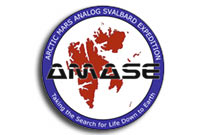AMASE 2009 expedition takes off in the Arctic

Juan D. Rodriguez (AMASE 2009 team member)
From August 1st to 24th 2009 AMASE (Arctic Mars Analog Svalbard Expedition) will be taking place in Svalbard (Norway, 76-81* N). This expedition involves different researchers from the Carnegie Institution of Washington, NASA/JPL, ESA, Cornell University, the Earth and Planetary Exploration Services (Norway), DLR (germany), the University of Valladolid (Spain) and the University of Leeds (UK).
AMASE has established Svalbard as a test bed for life-detection technology to fly on future NASA and ESA ‘Search for Life’ missions to Mars (i.e., Mars Science Laboratory, EXOMars). These expeditions have run since 2003 and are managed by Hans E.F. Amundsen (EPX, Norway), Andrew Steele and Marilyn Fogel (Carnegie Institution of Washington), Pamela Conrad (NASA,JPL) and Liane G. Benning (University of Leeds).
This year it will include more than 30 scientists and engineers from different disciplines (microbiology, geology, biogeochemistry, robotics, etc.) carrying out very different activities: from testing equipment that eventually would fly in future Mars missions to study the conditions in which extremophiles thrive in glacial ice and develop and test protocols to search for past and present habitable environments on icy planets, basically work that needs to be done before sending the next new generation of landers/rovers over the next few decades.
So far six AMASE expeditions have been carried out, testing different instruments that will fly aboard future Mars landers and also performing the procedures to detect signs of microbial life or organics in the subsurface of the Red Planet. The main goals for AMASE this year are to integrate and test two new instruments for the Mars Science Laboratory and four for the EXOMars mission using the FIDO (Field Integrated Design and Operations) rover from NASA/JPL as an advanced mobility platform, as well as test protocols for the future Mars Sample Return mission. The main research will be carried out in Bockkfjorden, Murchison Fjord and Wallenbergfjord, which are rich in carbonates, clays, basalts or water-ice that are considered good Martian analogue. The interest of combining the new instrumentation and the field work in these areas is not only for life-search testing procedures, but also for the different teams to work together, enhancing the integration between scientists from different institutions, fields and backgrounds that will work with a variety of instruments.
Also an important goal is to improve the way the instruments will give us the information we need: an absolutely fundamental requisite to study samples on Mars or return them to the Earth is to use completely clean and sterile instruments, not only to avoid detecting a life-signal that could actually have come from our own planet but also to avoid that microbiological contamination of Mars or any other planetary body in our Solar System.
Dr Juan Diego Rodriguez-Blanco, a Marie-Curie postdoctoral researcher that is working at the ‘Earth Surface Sciences Institute’ (ESSI), School of Earth and Environment (University of Leeds, United Kingdom), is participating as a mineralogist and -among many other things- he has decided to write of a daily blog with news and information, showing from a ‘personal vision’ the research that will be being carried out in AMASE.








